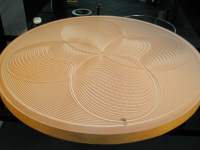|
 During the spring of 1998, as part of a collaboration with Jean-Pierre Hebert called "Ho," the idea for sand plotting emerged from our numerous experiments with motion control. Watching the sand paths being slowly and methodically created, only to be erased and redone, I was reminded of the myth of Sisyphus, a man condemned to forever roll a boulder up a hill only to find the next day that it had rolled back to the start. I designed and built two first-generation machines, giving one to Jean-Pierre as a gift. During the spring of 1998, as part of a collaboration with Jean-Pierre Hebert called "Ho," the idea for sand plotting emerged from our numerous experiments with motion control. Watching the sand paths being slowly and methodically created, only to be erased and redone, I was reminded of the myth of Sisyphus, a man condemned to forever roll a boulder up a hill only to find the next day that it had rolled back to the start. I designed and built two first-generation machines, giving one to Jean-Pierre as a gift.
While the two Sisyphus I's were xy-coordinate devices, covering about 30" x 30" of plotable territory, I created Sisyphus II for a public art competition (organized by Forecast Public Artworks, and hosted at the Science Museum of Minnesota) in the summer of 1999. This second generation device uses polar geometry to cover a circular area with a diameter of 5 feet.
 Sisyphus II now works continuously, in the Science Museum of Minnesota's Learning Technology Center. Recent work has enabled children to create designs (using Microworlds software) and then save them as paths for Sisyphus to plot. Sisyphus II now works continuously, in the Science Museum of Minnesota's Learning Technology Center. Recent work has enabled children to create designs (using Microworlds software) and then save them as paths for Sisyphus to plot.
Sisyphus III was installed at Technorama, The Swiss Science Center, near Zurich, in Sept. 2003. It is 10 feet in diameter and weighs about 1,000 lbs.
Finally, I created Sisyphus IV as a traveling version of the series. It is approximately 5 feet in diameter and 2 feet in height, and has traveled to London, Dublin, Belgium, and various places in the U.S.
|
